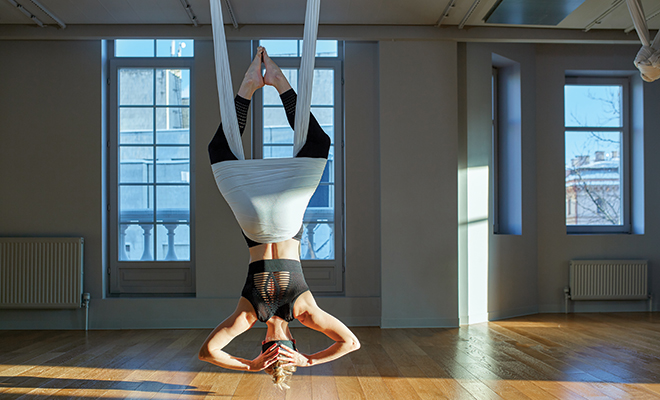
Fitness Heights: Suspension and Aerial Training
Perhaps you’ve wondered about those two long straps hanging in your gym, or maybe someone in your mom-group is raving about doing yoga poses in a lofty hammock. Sound interesting? Or intimidating? Maybe a little of both, but the fitness world loves training in the air, and it appears the trend is “hanging” around.
Suspension training was first developed over 20 years ago by a navy Seal on deployment. Using only a jiu jitsu belt and parachute webbing, the inaugural TRX® training system debuted. But these days there are a number of training systems and programs to choose from.
Suspension training can strengthen the body, improve balance and increase flexibility all while that body’s hovering above ground. During suspension workouts, the participant can either hang the legs or lean back while holding onto the straps and perform various moves and exercises.
Using your body weight and gravity as resistance, suspension training can build strength, balance, coordination, flexibility, core and joint stability. Any exercise you can do without suspension training, such as squats, lunges and planks, you can do suspended. It just makes the exercise more challenging.
Suspension Benefits and Risks
Suspension training can offer a number of benefits, including improved mobility, flexibility, core stability and functional strength. By simply leveraging your body weight to perform exercises, you get a full-body workout while simultaneously working your core. And because your weight can be adjusted easily, you can change exercises quickly and reduce the amount of actual training time.
Just like any other piece of fitness equipment, suspension trainers come with risks. Critics warn that the instability of suspension straps can result in injury, especially if you have a history of joint or back injuries, or inadequate core strength. A person’s lack of familiarity with suspension trainers or not having adequate training can result in poor form, inadequate exercises and even falls.
Research supports suspension training. In 2016, the American Council on Exercise completed an independent study in which 16 men and women took part in an eight-week TRX program. The study suggested that TRX training improves muscular fitness while simultaneously eliciting positive modifications in several major health risk factors. In one instance, the study showed a lowered resting blood pressure for all participants, and it was most noticeable for those with high blood pressure prior to the study.
Aerial Fitness
If you’re looking for something a little different than regular fitness classes, you may enjoy flying through the air with the greatest of ease! Aerial fitness is usually performed in a sling and focuses on three-dimensional movement, conditioning, joint rotation and mobility. Combining Pilates-type moves with core and strength training, aerial fitness can also be done using hoops, straps, loops, hammocks and other tools of varying sizes and shapes.
Aerial Risks and Benefits
Not only is there a certain fun factor, but working out in an aerial sling or hammock can allow participants to complete strengthening exercises and other yoga and Pilates moves that they might not otherwise be able to do. “Flying” fitness can increase range of motion and allow participants of all body sizes to go deeper into stretches and exercises. Doing poses inside the sling, usually made of very strong nylon or silk, provides support that can be helpful to beginning exercisers and advanced exercisers alike.
Can you get hurt? Yes, just like with any other class, you can manage to fall out of your sling or take a tumble, so signing a waiver before a class is normal. And like any other suspension training, the hanging sling is not a stable surface, so your body and muscles are working that much harder to stabilize themselves.
The price of suspension training and aerial fitness varies depending on whether you buy your own system or decide to take classes at the gym or fitness studio. Most systems run a few hundred dollars depending on the brand. Doing suspension training at the gym will cost you the membership fee and any other class or trainer fees. Plus, you get skilled instruction.
As far as space, you only need a little and a solid anchor for the straps, generally a stud in the wall or ceiling; a closed sturdy door may also work. Slowly suspending your own body weight on the trainer or sling is the best way to test the anchor point.
Intrigued? Well, all you have to do is figure out which training is right for you. As they say, you don’t know until you’ve tried it. Do what piques your interest and try it at least three times before you make a sound decision. Who knows? Maybe you will like suspension training and aerial fitness! Changing it up can make you rise to new heights! ■
Sources: acefitness.org, trxtraining.com, aerialfit.com and webmd.com







